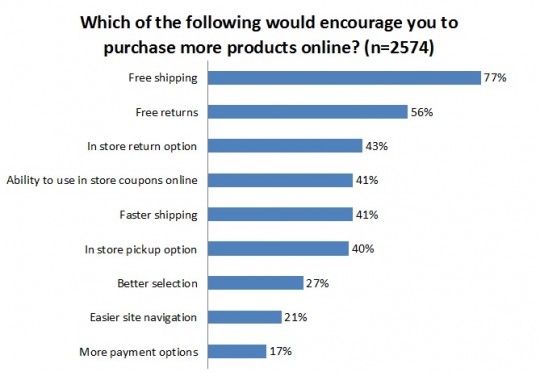What’s the Magic Word for Ecommerce Sites?
 Long before the Mad Men era, advertising experts knew that certain words get the attention of readers and spur them to action. One word has made just about every top ten list, and new research from Kantar Media shows this word remains as powerful in the online world as it was in print. The study surveyed at a large number of online shoppers (2500+) to determine what would motivate them to place an order.
Long before the Mad Men era, advertising experts knew that certain words get the attention of readers and spur them to action. One word has made just about every top ten list, and new research from Kantar Media shows this word remains as powerful in the online world as it was in print. The study surveyed at a large number of online shoppers (2500+) to determine what would motivate them to place an order.
Here’s the list of factors that motivated buyers:

Looking at the chart, it sticks out that by far the strongest motivators to make a purchase have one word in common: “FREE!” More than three out of four shoppers cited “free shipping” as the factor that would get them to purchase, and the second most common was “free returns.” This data underscores the fact that FREE! still works like a charm.
FREE! Is Special
A rational, economically motivated person would see very little difference between FREE and a very small amount. For example, if shipping for a $59 product was normally $7, “shipping reduced to just 25 cents” would be essentially the same as “free shipping.” The total order would be $59.00 one way, and $59.25 the other way – a difference so trivial as to be disregarded. In fact, to real, human online shoppers, these offers are very different.
As I described in The Power of FREE!, Amazon unwittingly ran that exact test years ago. They offered a free shipping deal across many countries, and sales increased in all countries except France. Puzzled, they checked and found that for some reason the French offer had been changed to a minimal shipping charge of about $.25. When the offer was changed to completely free, French buyers responded just like those in other countries.
Social science experiments have also shown that FREE! is far more powerful than really, really cheap. One experiment, also cited in the previous article, showed that people would choose a 15-cent chocolate truffle over a 1-cent chocolate kiss by a wide margin. The preference underwent a dramatic switch, though, when both prices were dropped by a penny, making the less appealing chocolate kiss free.
Perils of FREE
The use of FREE! isn’t entirely without risk. First, luxury brands need to be cautious about any kind of discount strategy that might cheapen their image. Second, temporary use of a FREE! strategy might tend to create an anchor point for the pricing of that product or service, making it more difficult to return to regular pricing. But that’s true of any temporary sale strategy, and many merchants are more than willing to risk the tradeoff for the sales boost that a limited-time offer will generate.
FREE! Strategies
A few ways your ecommerce sites use FREE:
- Free Shipping. It’s hard to overestimate the appeal of this offer. Many ecommerce firms have made it standard, while some use it as a temporary promotional strategy. Conversion expert Jeffrey Eisenberg has commented that one major site finds free shipping to be its top sales booster despite their low everyday shipping cost. (What? Consumers behave irrationally? Who knew?)
- Free Returns. Free returns have the attraction of FREE!, plus an additional appeal to another element of the human psyche: risk aversion. There’s little doubt that a key factor in the Zappos.com rise to stardom was their free return policy for women’s footwear. These products have a higher probability of return than most, and arguably were difficult to sell on the Web before Zappos took the risk and expense out of the process.
- Free Products or Upgrades. Is there an inexpensive companion product that most everyone will find useful? An upgrade, perhaps? A warranty extension? It may be more effective to run a sale with that item listed as FREE! rather than cutting the price of the original product. The best free offers, of course are those with a high perceived value. If you’ve ever tried to buy an HDMI cable at a big box electronics store, you’ll find they cost $20, $30, or more, despite a manufacturing cost of less than a buck or two. A clever ecommerce site could make a big deal about offering a product like this for free, incurring little direct cost but adding plenty of apparent value.
Does your experience with FREE! match the research? Have YOU found a clever way to exploit FREE! beyond the obvious ones above? Leave a comment!
